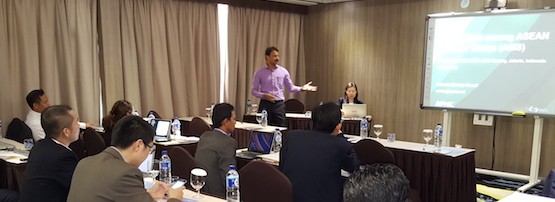
Last November, the Association of Southeast Asian Nations (ASEAN) launched its ICT Masterplan – AIM 2020 – for 2016 to 2020.
AIM 2020 encompasses eight strategic objectives that work together to support ICT adoption and enable innovation and advancements in the ASEAN community. Some of these objectives seek to continue initiatives from ASEAN’s previous Master Plan (AIM 2015), including those focused on improving IPv6 adoption.
Last month, I presented at an IPv6 deployment workshop for ASEAN government agencies that was held just before an ASEAN Telecommunications Senior Officials Meeting (TELSOM) in Jakarta, Indonesia. It was encouraging to hear about the efforts of ASEAN member nations supporting this important initiative and we were particularly grateful for the support from the Infocomm Development Authority of Singapore (IDA).
The workshop followed a survey of ASEAN government agencies on their IPv6 readiness that showed while some member nations had made good progress with their deployment plans, others still faced a range of challenges.
IPv6 Transition Programme, Singapore
In 2011, the IDA launched its IPv6 Transition Program to facilitate the smooth transition of the Singapore Infocomm ecosystem to IPv6. Under the program, the IDA has organized and implemented a range of awareness raising and engagement activities to help drive the transition to IPv6 among local industry.
Presenting at the IPv6 workshop, Jacqueline Chan, IDA, said the main reason Singapore developed its IPv6 strategy was because of the 2011 APNIC roadshow.
“In April 2011, APNIC’s assessment on the exhaustion of the unallocated IPv4 address pool by 2012 highlighted the importance for Singapore to ensure that it would be operationally ready to deploy IPv6,” said Jacqueline.
When asked why the IDA’s program has so far been a success, Jacqueline said that clear policy and strategy were needed to influence IPv6 adoption in Singapore.
The IDA’s strategy is to:
- Ensure domestic infocomm infrastructure has IPv6 capabilities instead of replacing IPv4 overnight.
- Incorporate requirements for coexistence of IPv4 and IPv6 in government-related requirements.
- Engage key stakeholders such as ISPs to facilitate their move towards a migration plan.
Vietnam National IPv6 Action Plan
The same year that the IDA launched its IPv6 programme, Vietnam’s National IPv6 Task Force launched its own National Action Plan towards transitioning to IPv6.
Speaking on behalf of the Task Force, Damg Duc Hanh, VNNIC, said the plan had some issues in its first three years, which required the task force to reevaluate and amend its objectives in 2014.
He said that recommendations produced as part of one of the AIM 2015 projects – Promote and Encourage the Deployment of IPv6 for Small and Medium Enterprises – helped with revising the Plan. This was a feature outcome noted in the AIM 2015 completion report.
Hanh said that although the amended plan had helped improve some of the issues, including increased awareness, IPv6 penetration rate was still low (0.03%) – a fact VNNIC have previously put down to a lack of usage by end users.
Vietnamese media have recently reported that Vietnam was lagging behind global IPv6 use. However, Hanh echoed his director’s comments on Vietnam’s IPv6 Day that VNNIC expects to see the penetration rate rise to 1-2% by next year’s IPv6 Day.
Following the survey and the workshop, APNIC will continue to work with ASEAN member nations to support their IPv6 deployment strategies.
The views expressed by the authors of this blog are their own and do not necessarily reflect the views of APNIC. Please note a Code of Conduct applies to this blog.
